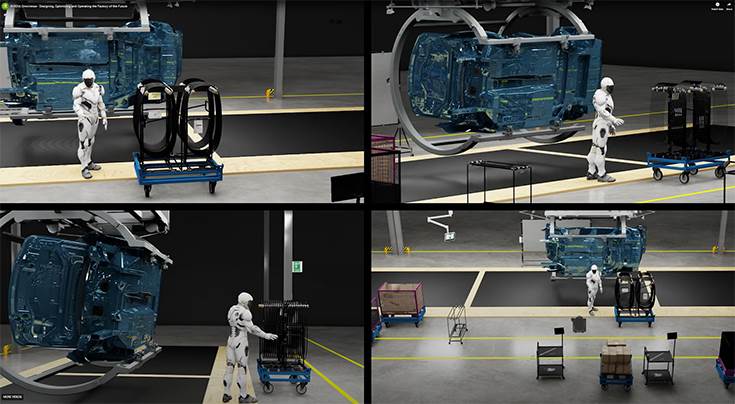The Automotive Hall of Fame, the premier institution which honours and celebrates individuals and their impact in the global automotive industry, has honoured Jensen Huang, founder and CEO of Nvidia with its Mobility Innovator Award, which recognises those whose new technologies and services are redefining mobility, at its 2023 Induction & Awards Ceremony held on July 20, in Detroit.
NVIDIA is a graphics-chip manufacturer that designs chips for games, data centres, and self-driving cars. Jensen Huang has been recognised for his work in transforming the transportation industry through AI and accelerated computing.
Commenting on being the recipient of the Mobility Innovator Award, Huang said: “AI and digitalisation are transforming every aspect of the automotive industry, from design and engineering to manufacturing, autonomous driving, and customer experience. It’s a thrill to make a contribution to this most vital of industries and a great honour to be recognized among its trailblazers.”
Huang was born in Taiwan, moved to Thailand, and emigrated to the U.S. as a child in 1973. He landed in Tacoma, Washington, to stay with his aunt and uncle. They sent him to a school in Kentucky – one which turned out to be a reform school, rather than a prep school as they had intended. There, he spent much of his time doing his assigned chores, taught his 17-year-old roommate to read, and picked up table tennis. He credits the defining experience with instilling in him the formidable work ethic which has contributed to his success today.
In the mid-1970s, Huang and his parents reunited in Oregon. He continued practicing table tennis, placing third in junior doubles at the U.S. Open Table Tennis Championship at age 15. In high school he also developed an interest in video games and computers. He enrolled at Oregon State University and earned a bachelor’s deree in Electrical Engineering in 1984. He waited tables for his first job in his 20s. After graduating from college, Huang worked as a chip designer at Advanced Micro Devices (AMD) and subsequently at LSI Logic, a tech company in California. In 1992 he obtained a master’s degree in Electrical Engineering from Stanford University.
That same year, Huang and Curtis Priem, a top engineer at Sun Microsystems, made plans to launch NVIDIA. On his 30th birthday in 1993, Huang left his job at LSI Logic. Shortly after, he established NVIDIA along with Priem and Chris Malachowsky. Over the next decade, the company faced numerous challenges, including competition, technology failures, staff issues, and tight finances. Ultimately, Huang learned that intellectual honesty had to be a pillar of the company culture, that mistakes had to be corrected early, and that adversity and the ability to admit failure fostered a rich corporate character.
 Above: Integrating Nvidia’s GPU chiplet into the MediaTek Dimensity Auto platform, the two companies aim to come up with a full range of AI cabin and cockpit functions with cutting-edge graphics, AI, safety and security features.
Above: Integrating Nvidia’s GPU chiplet into the MediaTek Dimensity Auto platform, the two companies aim to come up with a full range of AI cabin and cockpit functions with cutting-edge graphics, AI, safety and security features.
 Inside the digital twin of BMW’s assembly system, powered by Omniverse, an entire factory in simulation. (Image: Nvidia.com)
Inside the digital twin of BMW’s assembly system, powered by Omniverse, an entire factory in simulation. (Image: Nvidia.com)
In 1999, NVIDIA became the first company to develop graphical processing units (GPUs) and the first to use them for artificial intelligence technology. More recently, NVIDIA has been revolutionizing the automotive industry with its foray into autonomous vehicle technology. Since the 2010s, the company has partnered with top automakers, including Audi, Mercedes, Toyota, BMW, Rimac, Jaguar Land Rover, Hyundai, Volvo, Volkswagen, GM, Lotus, and NIO.
NVIDIA’s automotive technology ranges from design and engineering visualization for vehicle developers, virtual showrooms for personalized retail experience and built-in intelligent assistants, to self-driving and self-parking software. One of the major challenges to dominating this industry is ensuring vehicle safety, a goal which NVIDIA is supporting with thousands of dedicated engineers as it further develops its DRIVE platforms. Their technology is heralded as some of the best in the industry, and in a quickly evolving field NVIDIA and Huang have proven that they can keep up.
 More than 50 automotive companies have deployed over 800 autonomous test vehicles powered by the Nvidia Drive Hyperion compute architecture.
More than 50 automotive companies have deployed over 800 autonomous test vehicles powered by the Nvidia Drive Hyperion compute architecture.
Nvidia Drive Hyperion platform
More than 50 automotive companies around the world have deployed over 800 autonomous test vehicles powered by the Nvidia Drive Hyperion automotive compute architecture. Nvidia Drive embedded supercomputing platforms process data from camera, radar, and lidar sensors to perceive the surrounding environment, localize the car to a map, then plan and execute a safe path forward. This AI platform supports autonomous driving, in-cabin functions, and driver monitoring, plus other safety features—all in a compact, energy-efficient package.
Nvidia Drive Hyperion is a production-ready platform for autonomous vehicles. This AV reference architecture accelerates development, testing, and validation by integrating DRIVE Orin™-based AI compute with a complete sensor suite that includes 12 exterior cameras, three interior cameras, nine radars, 12 ultrasonics, and one front-facing lidar, plus one lidar for ground truth data collection. DRIVE Hyperion features the full software stack for autonomous driving (DRIVE AV) as well as driver monitoring and visualization (DRIVE IX), which can be updated over-the-air, adding new features and capabilities throughout the life of the vehicle. It’s also designed to be compatible across generations, so partners can leverage current investments in the DRIVE Orin platform and seamlessly migrate to NVIDIA DRIVE Thor and beyond in the future.
Lead Image: NVIDIA
ALSO READ:
MediaTek and Nvidia to develop AI cabin solutions for software-defined vehicles
Quest Global to use Nvidia’s Omniverse digital twin solutions for manufacturing industry
